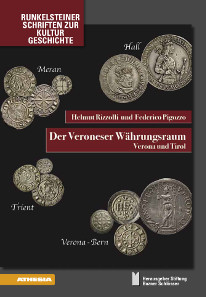
PREV ARTICLE
NEXT ARTICLE
FULL ISSUE
PREV FULL ISSUE
BOOK REVIEW: THE VERONESE CURRENCY AREA
Ursula Kampmann published this review of a new book on the monetary history of the Veronese currency area (Northern Italy and the Alpine
region) in the November 20, 2015 issue of CoinsWeekly. Here is an excerpt. Be sure to read the complete review online. -Editor
The Swiss National Bank is not happy: In theory, 60 % of the Swiss monetary value is circulating in 1000 francs notes. In fact, however, these grands almost never show up. This paradox can only be explained with a gaze into the human psyche. If the homo oeconomicus is given the choice between different currencies, he is inclined to favor the one with the most stable value, if he intends to hoard the money, and the most commonly accepted one, if he intends to use it for payments. Guide to the monetary history of the Veronese currency area
Internationally accepted change
Late in the 10th century, the coins not only circulated in the Veronese currency area but made their way as far north as Poland and Sweden. According to the account of a Spanish traveler visiting the market place of Prague in 966, ten chickens or enough oats to feed a riding horse for forty days could be purchased with a denarius in the full weight. Anyone planning on just roasting a chicken and not carrying a great deal of oats rather resorted to the Veronese denarius since this coin was lighter and hence more comfortable to use in every-day life. Type corpus of coinages from Verona and Tyrol
The second corpus is nothing less than a Corpus Nummorum Tirolensium Mediaevalium that is based on two ground-breaking works of Helmut Rizzolli, published in 1991 and 2006 (which are out of stock, needless to add). All newly discovered coin types and variants had been carefully added by Armin Torggler. This part includes the coinages of the bishops of Trent, the dukes of Tyrol-Görtz and the Habsburgs from the Merano Mint, as well as imitations of coins from Merano. Coins following the Venetian standard from Lienz and Toblach conclude the corpus. A comprehensive bibliography, an index of sites of coin finds and the biographies of all persons included round out the monumental opus. It also programmatically includes the vita of late Ottorino Murari, the coin collector who had died in 1991. A renowned expert in the history of Veronese currency, he combined his academic interest with his passion for collecting and thus greatly contributed to the studies on the Veronese monetary history. The two authors Helmut Rizzolli and Federico Pigozzo devoting their work to Ottorino Murari bears testimony to their collector-friendly attitude. But this is not the only aspect that reflects the respect the authors foster towards the lay-man. Their book is devoid of any technical jargon. In a down-to-earth manner, they reconstruct the monetary history of the Veronese currency area to the effect that everybody can follow them. Do you need a recommendation? It is rather simple: Don’t just buy it, read it! The easiest way to get a copy of the book is by ordering it at Amazon. Of course, it may also be purchased directly from the publisher, Athesia Verlag. To read the complete article, see:
THE BOOK BAZARREWayne Homren, Editor The Numismatic Bibliomania Society is a non-profit organization promoting numismatic literature. See our web site at coinbooks.org. To submit items for publication in The E-Sylum, write to the Editor at this address: whomren@gmail.com To subscribe go to: https://my.binhost.com/lists/listinfo/esylum All Rights Reserved. NBS Home Page Contact the NBS webmaster 
|
 Helmut Rizzolli, Federico Pigozzo, Der Veroneser Währungsraum. Verona und Tirol vom Beginn des 10.
Jahrhunderts bis 1516 und Corpus Nummorum Veronensium (CNV), Corpus Nummorum Tirolensium Mediaevalium (CNTM), Runkelsteiner Schriften
zur Kulturgeschichte Bd. 8. Bozen, Athesia, 2015. 729 p., color illustrations throughout. Hardcover. 17.1 x 24.5 cm. ISBN:
978-88-6839-139-3. 69,00.
Helmut Rizzolli, Federico Pigozzo, Der Veroneser Währungsraum. Verona und Tirol vom Beginn des 10.
Jahrhunderts bis 1516 und Corpus Nummorum Veronensium (CNV), Corpus Nummorum Tirolensium Mediaevalium (CNTM), Runkelsteiner Schriften
zur Kulturgeschichte Bd. 8. Bozen, Athesia, 2015. 729 p., color illustrations throughout. Hardcover. 17.1 x 24.5 cm. ISBN:
978-88-6839-139-3. 69,00.